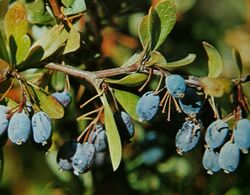Biology:Berberis libanotica
| Berberis libanotica | |
|---|---|

| |
| Scientific classification | |
| Kingdom: | Plantae |
| Clade: | Tracheophytes |
| Clade: | Angiosperms |
| Clade: | Eudicots |
| Order: | Ranunculales |
| Family: | Berberidaceae |
| Genus: | Berberis |
| Species: | B. libanotica
|
| Binomial name | |
| Berberis libanotica Ehrenb. ex C.K.Schneid.
| |
Berberis libanotica is a species of plant in the family Berberidaceae. It is a shrub, that grows in temperate regions and is native to Lebanon and Syria.
Taxonomy
It was first published by Austrian botanist Camillo Karl Schneider (1876–1951) in Ill. Handb. Laubholzk. vol.1 on page 310 in 1905, based on an earlier description by Ehrenb. (1795-1876).[1][2][3]
It was originally found Libanon (the German name) for Lebanon.[1]
Berberis libanotica is considered by C. Schneider and most botanists after him as specifically distinct from B. cretica L. It is however very close to it and differs only by the absence of stomata on the upper side of the leaves, and is rarely synonymized under Berberis cretica.[4]
Uses
It is a medicinal plant well known to the Lebanese, who make use of the solution obtained by maceration of its roots in tepid water for treating certain liver and gall bladder diseases. The investigation of its active agents was the topic of a doctorate dissertation in pharmacy submitted by J. Ades in 1948 at the French Faculty of Medicine, Beirut.
Description
Shrubby tree reaching up to 1.50 metres (4 ft 11 in). Branches blackish red. provided with strong yellow spines, close to each other, often 3-parted. Leaves glabrous, sessile, 15–25 millimetres (0.59–0.98 in) long over 5–7 millimetres (0.20–0.28 in) wide, strongly innerved. It flowers between May and June. Inflorescence in racemes smaller than leaves. Perianth made of 6 petal-like yellow sepals, 4–5 millimetres (0.16–0.20 in) in diameter. Stamens ; anthers oval. Ovary topped by a thick sessile stigma. Fruit an ovate blackish berry.
Distribution and habitat
It is found in the middle East.[2]
Geographic area
It is native to Lebanon and Syria.[2]
Habitat
It is found on mountains, including the eastern slope of Hermon, Antilebanon.[5] At altitudes of 1,600 and 2,200 m (5,200 and 7,200 ft) above sea level.[1]
References
- ↑ 1.0 1.1 1.2 Schneider, Camillo (1906). "Illustriertes Handbuch der Laubholzkunde :Charakteristik der in Mitteleuropa heimischen und im freien angepflanzten angiospermen Geho¨lz-Arten und Formen mit Ausschluss der Bambuseen und Kakteen". G. Fischer. https://www.biodiversitylibrary.org/page/448496#page/331/mode/1up.
- ↑ 2.0 2.1 2.2 "Berberis libanotica Ehrenb. ex C.K.Schneid. | Plants of the World Online | Kew Science" (in en). https://powo.science.kew.org/taxon/urn:lsid:ipni.org:names:60450141-2.
- ↑ "WFO (2023): Berberis libanotica Ehrenb. ex C.K.Schneid". https://www.worldfloraonline.org/taxon/wfo-0000563447.
- ↑ "Berberis cretica L". https://www.gbif.org/species/7684385.
- ↑ Mustapha Nehmeh, Wild Flowers Of Lebanon, National Council For Scientific Research, 1978, pages 166, 167.
- Danin, A. & Fragman- Sapir, O. (2019). Flora of Israel Online http://flora.org.il/en/plants.
- Georges Tohme & Henriette Tohme, Illustrated Flora of Lebanon, National Council For Scientific Research, Second Edition 2014.
Wikidata ☰ Q15335491 entry
 |

